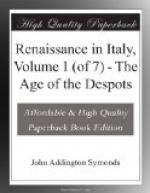One of the most picturesque figures of the first half of the thirteenth century is the Dominican monk, John of Vicenza. His order, which had recently been founded, was already engaged in the work of persecution. France was reeking with the slaughter of the Albigenses, and the stakes were smoking in the town of Milan, when this friar undertook the noble task of pacifying Lombardy. Every town in the north of Italy was at that period torn by the factions of the Guelfs and Ghibellines; private feuds crossed and intermingled with political discords; and the savage tyranny of Ezzelino had shaken the fabric of society to its foundations. It seemed utterly impossible to bring this people for a moment to agreement. Yet what popes and princes had failed to achieve, the voice of a single friar accomplished. John of Vicenza began his preaching in Bologna during the year 1233. The citizens and the country folk of the surrounding districts flocked to hear him. It was noticed with especial wonder that soldiers of all descriptions yielded to the magic of his eloquence. The themes of his discourse were invariably reconciliation and forgiveness of injuries. The heads of rival houses, who had prosecuted hereditary feuds for generations, met before his pulpit, and swore to live thenceforth in amity. Even the magistrates entreated him to examine the statutes of their city, and to point out any alterations by which the peace of the commonwealth might be assured. Having done his best for Bologna, John journeyed to Padua, where the fame of his sanctity had been already spread abroad. The carroccio of the city, on which the standard of Padua floated, and which had led the burghers to many a bloody battle, was sent out to meet him at Monselice, and he entered the gates in triumph. In Padua the same exhortations to peace produced the same results. Old enmities were abandoned, and hands were clasped which had often been raised in fierce fraternal conflict. Treviso,




